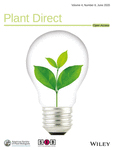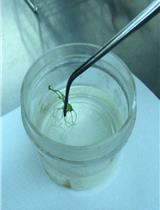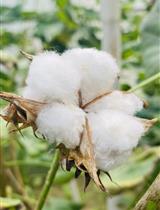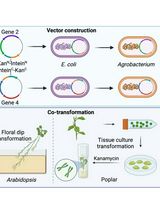- EN - English
- CN - 中文
Agrobacterium-mediated Transformation of Sweet Basil (Ocimum basilicum)
农杆菌介导的罗勒(Ocimum basilicum)转化
发布: 2020年11月20日第10卷第22期 DOI: 10.21769/BioProtoc.3828 浏览次数: 5638
评审: Sriema L. WalawageAnonymous reviewer(s)
Abstract
Sweet basil (Ocimum basilicum) is a popular herb with high economic value and is currently threatened by a severe oomycete disease. An efficient transformation method is a prerequisite for gene functional analysis to accelerate molecular breeding and deploy effective disease management strategies, and breeding through genetic engineering. Here we present a detailed protocol for a highly efficient Agrobacterium tumefaciens-mediated transformation method for sweet basil, which was established based on a previously reported method by other researchers, with modifications on several aspects, including growth of sweet basil, age of plants used for explants, preparation and concentration of Agrobacteria. This protocol allows researchers in academia and agroindustry to generate transgenic sweet basil plants in an easy, quick and highly reproducible manner. In addition, this protocol may be applicable to transform other species within the genus Ocimum.
Keywords: Sweet basil (罗勒)Background
Sweet basil (Ocimum basilicum) is a popular herb, holding high economic value for its significant medicinal, culinary and cosmetic properties. Its global production is hampered by severe downy mildew disease caused by the oomycete pathogen Peronospora belbahrii. Traditional breeding involving interspecific hybridization in sweet basil has been a hassle with F1 sterility and difficulty in segregating out undesirable traits. On the other hand, genetic engineering of sweet basil offers a platform to study molecular biology, broaden sources of desirable traits and accelerate breeding process. A highly efficient CRISPR/Cas9-mediated gene editing system for targeted mutagenesis of ObDMR1 gene was established for sweet basil using Agrobacterium-mediated stable transformation (Navet and Tian, 2020). Two independent constructs were used for transformation to express gene-editing reagents. With NPTII gene as the selectable marker, we obtained 34 and 48 kanamycin-resistant regenerated plants from 176 and 238 explants, yielding a transformation efficiency of 19.3% and 20.2% respectively. All kanamycin-resistant plants were tested positive for transgene integration. The transformation method we described (Navet and Tian, 2020) differs from the previous Agrobacterium-mediated transformation of sweet basil established by Deschamps and Simon (2002), which utilized the regeneration protocol by Phippen and Simon (2000), in certain aspects: mainly, growth of sweet basil, age of plants selected for explants, preparation of Agrobacteria, and Agrobacterium concentration used to infect explants. We established the protocol using sweet basil cultivar Genoveser. To shorten and simplify the process we used leaf discs from small young leaves (contrary to fully expanded leaves) as explants and a simple method to prepare Agrobacteria. Our lab has been successful in transforming sweet basil with diverse plant binary vectors following this method. Here we provide a detailed protocol for this convenient and reliable transformation method through which transgenic sweet basil plants with stable inheritance of the transgene can be quickly generated. This protocol is expected to enable researchers in academia and agroindustry to meet their needs in basil functional genomics and breeding for desirable traits.
Materials and Reagents
Biological Materials
Seeds of sweet basil cultivar Genoveser (Enza Zaden)
Agrobacterium tumefaciens strain EHA105 harboring binary vector pKSE401 derived plasmids, which contain NPTII as a selectable marker gene
Chemicals
Kanamycin sulfate (VWR International, catalog number: 89149-900 )
Rifampicin (Santa Cruz, catalog number: sc-200910 )
Luria-Bertani (LB) Broth, Miller (Fisher Scientific, catalog number: BP1426-2 )
Agar (VWR International, catalog number: AAA10752-36 )
Dimethyl sulfoxide (DMSO) (Sigma-Aldrich, catalog number: D8418 )
3′,5′-Dimethoxy-4′-hydroxyacetophenone (Acetosyringone) (Sigma-Aldrich, catalog number: D134406 )
Murashige and Skoog (MS) basal medium (Sigma-Aldrich, catalog number: M5519 )
Sucrose (Sigma-Aldrich, catalog number: S7903 )
Phytoagar (PlantMedia, catalog number: 40100072-1 )
Thidiazuron (TDZ) (PlantMedia, catalog number: 30631018-2 )
1-Naphthaleneacetic acid (NAA) (PlantMedia, catalog number: 30631016-1 )
Timentin (PlantMedia, catalog number: 42010012-3 )
Clorox Regular Bleach Disinfectant with Cloromax (Sodium hypochlorite 6%) (Clorox)
MilliQ water, generated using Synergy Water Purification System (EMD Millipore)
Glassware, plasticware and other consumables
Sterile Petri dishes for bacterial growth (100 x 15 mm, BD Falcon, catalog number: 351029 )
1.5 ml micro-centrifuge tubes
Spectrophotometer cuvettes
Syringe Filter (0.2 µm) (VWR International, catalog number: 28145-477 )
Sterile pipette tips (20, 200, 1,000 µl)
Sterile 15 ml and 50 ml conical tubes (VWR International, catalog numbers: 82050-276 and 82050-346 )
Glass media bottles
Cork borer (Number #2)
Sterile paper towel (Scott® C-Fold Towels) (VWR International, catalog number: 10815-570 )
Sterile forceps and scalpel (sterilized by autoclaving)
Cell culture dishes (100 x 20 mm, Greiner Bio-One, catalog number: 664160-TRI )
Plant culture containers with lid (190 ml, Greiner Bio-One, catalog number: 967161 )
3MTM MicroporeTM Surgical Tape (3M Healthcare, catalog number: 1530-0 )
Aluminium foil
3.5” square plant pots
Soil Mix (e.g., SunGro Horticulture Sunshine Mix #4)
Plastic flats (1020 Trays, Heavy Duty) and dome (7” Vented Humidity Dome for 1020 Tray) for plant growth (Greenhouse Megastore, catalog numbers: CN-FLHD and PR-DOME7 )
Media and solutions
Stock solutions of antibiotics, plant growth regulators and other solutions
Kanamycin (50 mg/ml) (see Recipes)
Rifampicin (25 mg/ml) (see Recipes)
Timentin (200 mg/ml) (see Recipes)
TDZ (1 mg/ml) (see Recipes)
NAA (0.5 mg/ml) (see Recipes)
Acetosyringone (AS) (0.2 M) (see Recipes)
12% (v/v) Clorox Regular Bleach Disinfectant solution (see Recipes)
Media for Agrobacterium
LB agar (see Recipes)
Agrobacterium Inoculation media (IN) (see Recipes)
Media for sweet basil regeneration
Callus and shoot induction (SI) media (see Recipes)
Root induction (RI) media (see Recipes)
Equipment
-80 °C freezer
Autoclave (any model that allows a temperature of 121 °C)
Plant growth chamber (any model with temperature and light control)
Incubator shaker (e.g., New Brunswick Scientific, model: Excella E25 )
pH meter (e.g., ThermoFisher, Orion Star A111 )
Laminar flow hood (e.g., LABCONCO, model: 36125 )
Pipetman® 20, 200,1000 µl (e.g., RANIN, Pipet-Lite XLS )
Spectrophotometer (e.g., Eppendorf, 6131 23550 )
Orbital shaker (e.g., Heidolph Rotamax 120 Orbital Platform Shaker)
Plant tissue culture room with controlled light and temperature
Procedure
文章信息
版权信息
© 2020 The Authors; exclusive licensee Bio-protocol LLC.
如何引用
Navet, N. and Tian, M. (2020). Agrobacterium-mediated Transformation of Sweet Basil (Ocimum basilicum). Bio-protocol 10(22): e3828. DOI: 10.21769/BioProtoc.3828.
分类
植物科学 > 植物转化 > 农杆菌介导的转化方法
分子生物学 > DNA > 转化
您对这篇实验方法有问题吗?
在此处发布您的问题,我们将邀请本文作者来回答。同时,我们会将您的问题发布到Bio-protocol Exchange,以便寻求社区成员的帮助。
Share
Bluesky
X
Copy link












